XBee® is a registered trademark of Digi International. Digi XBee is a family of cellular modems and radio frequency modules that provides a range of popular wireless protocols for rapid prototyping and fast time-to-market. But how do you choose one? This Digi XBee comparison guide will help you select the best XBee for your use case.
XBee modules provide wireless connectivity for connected devices in the machine-to-machine (M2M) and Internet of Things (IoT) marketplace. The complete
Digi XBee ecosystem includes modules, code libraries, and
developer tools. Together, these resources help to simplify and expedite design, coding, manufacturing and deployment. Pre-certified modules eliminate the pain and expense of the certification process.
Whenever you need additional design and engineering assistance, the experts with Digi
Wireless Design Services are always available to help you.
What Is an XBee Module?
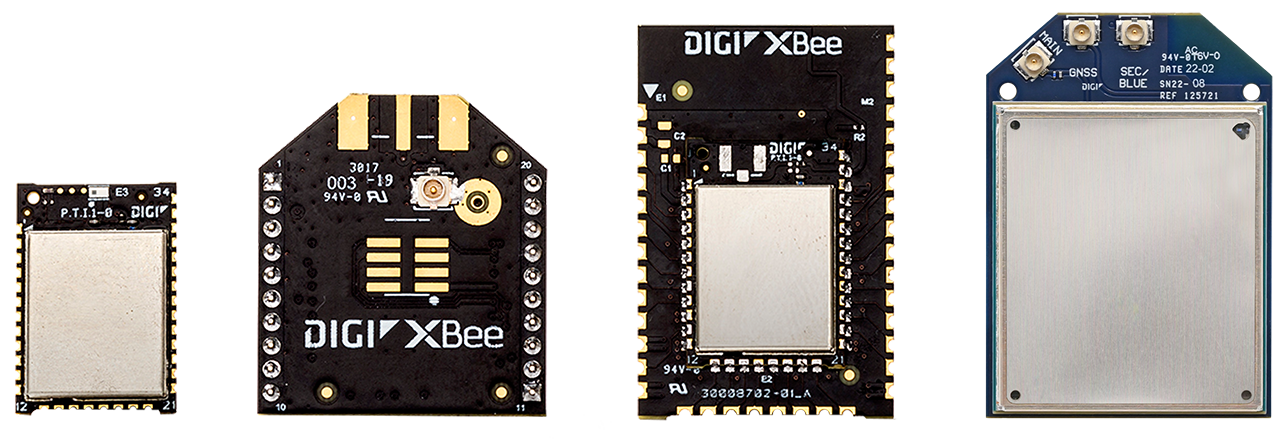 An XBee module is a very small radio device that uses various communication protocols to send information, such as data from a sensor. Radio frequency (RF) XBee modules communicate through a gateway, while cellular XBees connect over cellular networks. That’s the Digi XBee definition. Let’s talk about features, use cases, and how to compare XBees.
An XBee module is a very small radio device that uses various communication protocols to send information, such as data from a sensor. Radio frequency (RF) XBee modules communicate through a gateway, while cellular XBees connect over cellular networks. That’s the Digi XBee definition. Let’s talk about features, use cases, and how to compare XBees.
Digi XBee modules are robust, versatile, secure and reliable, making them the popular choice for adding wireless communications to connected products. Digi XBee radios are used in every imaginable IoT application, from industrial sensing, smart agriculture and asset tracking to smart city lighting.

Here are some key XBee features:
- Pin-compatibility, making it easy and economical to switch between solutions.
- A common hardware/software platform, configuration interface and programming environment, enabling easy transition between product lines and protocols.
- Global certifications for multi-regional deployments.
- Easy-to-use Digi XBee Tools, APIs, and code libraries, MicroPython programmability and optional Bluetooth configuration enable developers to develop, deploy and manage devices.
Let’s look at XBee options for protocols, frequencies, antennas and form factors.
- XBee range comparison: With an outdoor range of up to 65 miles, the Digi XBee-PRO SX 900 module can bridge the large distances needed for remote deployments. For local networks, Digi XBee 3 PRO modules can create point-to-multipoint or mesh networks with indoor distances of around 300 feet between nodes.
- XBee power consumption: Shorter range modules, like Digi XBee 3 Zigbee or Digi XBee RR can transmit using only 33 mA of current. Longer range modules like Digi XBee-PRO SX 900 may consume up to 900 mA of current, but cover distances over 300 times greater. Cellular devices like Digi XBee 3 Cellular LTE-M/NB-IoT average around 200 mA, providing long battery life for devices on-the-go.
- Frequency: Digi XBee 3 Global Cellular modules support multiple LTE bands, for mobile device deployments across multiple continents. Other Digi XBees such as the Wi-Fi, XBee RR, Zigbee, DigiMesh and 802.15.4 modules operate on the globally-licensed 2.4 GHz bands. Digi’s sub-1 GHz long-range modules operate in the 900 MHz range for North America and in the 868 MHz range for Europe.
- Antenna: Many antenna options are available for Digi XBees, including simple wire or whip, PCB trace, and chip antennas. Connector options include RPSMA and U.FL. Some modules also support an RF pad for SMT antenna connections. (More detail below.)
- Protocol: Choose from point-to-multipoint 802.15.4, mesh networking with Zigbee or DigiMesh, standards-based Wi-Fi, long-range 900/868 MHz solutions, and a variety of IoT-ready cellular modules, with common footprints and a common interface.
Download our XBee Family Features Comparison Chart
Compare our various XBee modules and find the perfect fit for your application
Download PDF
What Are the Use Cases for XBee Modules?
We've touched on a few of the applications where Digi XBee modules are deployed across the globe. Yet there are so many more! Wherever machinery and systems need to be automated and monitored, wherever sensors need to be deployed, and wherever wireless communications between machinery and applications is a critical business function, you will find XBee.
Digi XBee modules provide the remote communication for agriculture, industry, solar fields, wind farms, telematics, robotics, water management, autonomous vehicles and other transportation use cases. Be sure to peruse our Customer Stories, and filter by "Digi XBee."
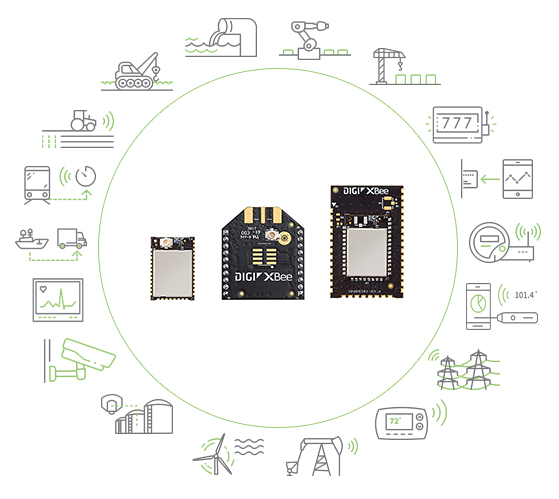
The Evolution of XBee

The XBee radio module was introduced in 2005 by MaxStream. Digi bought MaxStream the next year and launched a certified Zigbee XBee module. These products proved so popular that Wi-Fi modules followed. Third-parties began building sockets for Digi XBee into their own products. Then in 2018, Digi introduced the Digi XBee 3 line of programmable modules. The family grew, with additional XBee module range and cellular options, and an ecosystem of supporting software, libraries and tools to simplify XBee development. Here’s a quick overview of XBee evolution:
- 802.15.4: Introduced in 2005, these “Series 1” modules were the first to feature the classic 20-pin XBee footprint, and support the IEEE 802.15.4 standard. Their simple AT command interface became a standard across the XBee line. This module was popular with the Maker community — many of whom were the Internet of Things pioneers.
- Zigbee: Building on XBee’s success, Digi revealed a “Series 2” Zigbee mesh networking-enabled XBee module. Zigbee modules automatically form networks. The “self-healing” network can route around offline modules, making Zigbee perfect for industrial sensing systems.
- Wi-Fi: Digi’s original XBee Wi-Fi released in 2011 with global Wi-Fi protocol support. A second version launched the following year with over-the-air updates.
- LTE Cat 1: Digi XBee LTE Cat 1 marked Digi’s entrance into the cellular market. Aimed at connected devices with lower-bandwidth needs, it supported connectivity for applications where Wi-Fi isn’t available.
- LTE Cat 4: The latest module in the LTE lineup extends support for higher bandwidth needs such as streaming media files or transmitting very high frequency data samples.
- LTE-M/NB-IoT: After XBee LTE Cat 1, Digi developed and certified modules supporting the LTE-M and NB-IoT cellular protocols. These standards can keep battery-operated devices running and connected to cellular networks for lengthy periods.
- DigiMesh® RF modules: Digi developed DigiMesh to address gaps in Zigbee functionality. In a DigiMesh network, all modules are the same device type and can be battery powered, which improves provisioning and creates a resilient network without requiring always-on router modules. DigiMesh can run on 2.4 GHz or 868/900 MHz.
- 868/900MHz: Digi XBee-PRO 900HP and Digi XBee XR 868 cover a 9-mile range, with mesh networking options. Digi XBee SX 868/900 includes DigiMesh and can be configured for a range of 65 miles.
Video: Introduction of Digi XBee 3 Programmable Modules
XBee and Zigbee
What is Zigbee, and how does it differ from XBee? XBee and Zigbee are sometimes confused because both have a “Bee” in their branding. But whereas XBee is a radio module, Zigbee is a secure communications protocol standard for low-power, local-area wireless mesh networking that operates on global frequencies. XBee modules run Zigbee and many other protocols, making it easy and cost-effective to develop wireless applications.
XBee PRO vs XBee
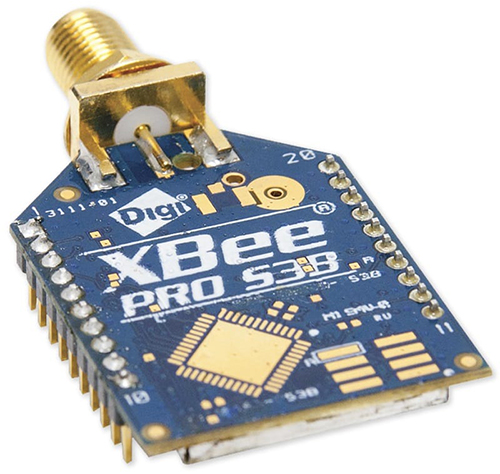 Several Digi XBee lines come in both regular and PRO versions. The main difference between the two is transmission power, and therefore XBee range.
Several Digi XBee lines come in both regular and PRO versions. The main difference between the two is transmission power, and therefore XBee range.
Regular XBee: The regular versions of Digi XBee 3 RF, Digi XBee RR and Digi XBee SX support medium range applications, requiring a modest amount of transmission power. They use less energy, so batteries last longer, and they generate less heat, are lower-cost, and can be certified in regions that allow only low-power transmissions.
XBee PRO: The Digi XBee-PRO radios include Digi XBee 3 PRO, Digi XBee RR PRO, Digi XBee-PRO 900HP and Digi XBee-PRO SX. PRO modules are considered long-range, for distances from 2 miles up to 65 miles.
XBee Series 1 vs Series 2
Until 2014, XBees used a “series” to describe different modules. Today many sites still compare the two so let’s compare XBee Series 1 vs. Series 2
XBee Series 1: The Series 1 XBee is the same as the Digi XBee 802.15.4. It was called the Series 1 because it was the first XBee ever made, and to distinguish it from the subsequent Series 2 line.
XBee Series 2: The Series 2 XBee is identical to the Digi XBee Zigbee module. It is also similar to the Digi XBee 3 Zigbee module, which added programmability, additional form factors, Bluetooth and other features.
While the “series” nomenclature was replaced by more descriptive terminology, it’s helpful to understand these older Digi XBee definitions.
Related content: Digi XBee Turns 15! Take a Whirlwind History Tour

XBee Buying Guide: Every XBee Explained
The Digi XBee line has three broad groups. There are short-range low-power radios, long-range modules that require more energy to carry signals over distances, and Digi XBee cellular modems that join mobile networks.
- 2.4 GHz (short range, low power)
- Sub-1 GHz (long range, more power)
- Cellular
The following table lists range capabilities and power requirements for the current Digi RF and cellular modules. Ranges are the maximum to expect, and are affected by factors including antennas, local area networks and cellular availability.
2.4 GHz RF Modules (Short Range, Low Power)
Using the globally-accepted 2.4 GHz frequency, these Digi XBee modules can be deployed almost anywhere for short-range connectivity with excellent battery life.
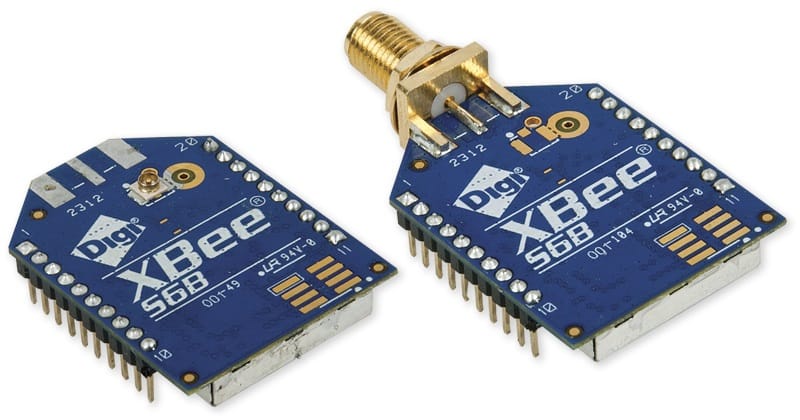
Digi XBee Wi-Fi: With flexible design options, simple provisioning tools and native support for Digi Remote Manager®, this module allows developers to bring cloud-connected Wi-Fi products to market quickly, with minimal effort or cost.
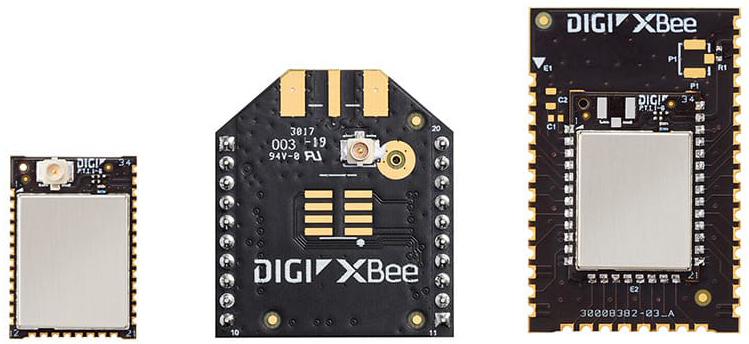
Digi XBee 3 Modules: Micromount, Through-hole, Surface Mount
Digi XBee 3 Zigbee: This module creates interoperable mesh networks using the Zigbee protocol standard. Zigbee has been part of the XBee line from the beginning. Digi XBee 3 Zigbee modules come in three compatible sizes, with Bluetooth and programmability onboard.
Digi XBee 3 802.15.4: The 802.15.4 IEEE standard provides fast connectivity, often with no configuration required. Flexible and battery-saving, these modules are available in three Digi XBee 3 footprints with BLE, MicroPython and Digi TrustFence® security.
Digi XBee DigiMesh 2.4: For applications where interoperability with third party devices isn’t required, DigiMesh provides an excellent mesh network with some distinct advantages over Zigbee, including simplicity and improved power management. The Digi XBee 3 version is programmable, BLE addressable and secure.
Digi XBee RR: Digi XBee RR wireless modules accelerate time-to-market for designers, OEMs and solution providers by quickly enabling wireless connectivity and easy-to-add functionality.
Sub-1 GHz RF Modules (Long Range, More Power)
Several Digi XBee long range modules operate in the 900 MHz and 868 MHz bands, license-free in North America and Europe respectively. Lower frequency ranges allow greater signal propagation, typically in exchange for a bit more power draw.
Digi XBee-PRO XSC: This 900 MHz module provides over-the-air compatibility with legacy 9XStream products. For new designs the Digi XBee-PRO 900HP should be used.
Digi XTend 900 MHz: These modules provide support for Digi’s legacy 9XTend module form factor, with a range of up to 40 miles.
Network topologies include point-to-point, point-to-multipoint and mesh.
Digi XBee SX 868
and 900: One of the most powerful and technically advanced solutions in the XBee line, the 1-Watt 900 MHz Digi XBee-PRO SX 900 and battery-optimized 20 mW XBee SX 900 and 868 MHz modules can span a line-of-sight range of 65 miles or 9 miles respectively. Both include a choice of DigiMesh or point-to-multipoint topologies and AES encryption for secure data communications.
Digi XBee-PRO 900HP: This long-range 900 MHz module provides line-of-sight connectivity range up to 28 miles. It uses the compatible through-hole XBee footprint, multi-regional flexibility, and data rates up to 200 Kbps, ideal for long-range applications requiring increased data throughput.
Video: Range Testing with Digi XCTU
XBee Cellular Modems
Digi XBee cellular modules provide mobile data connectivity in a familiar form factor. These pre-certified modules provide the easiest way to integrate cellular connectivity into OEM devices. Optimized for IoT low-power/low-bandwidth requirements, each comes with a development kit for rapid prototyping. All feature integrated MicroPython programmability, MQTT support for cloud platforms like Azure and AWS, Bluetooth Low Energy for beaconing, connecting to sensors and local configuration using the Digi XBee Mobile app.
Today you can configure and test Digi XBee Cellular solutions with Digi XBee Studio — a free multi-platform application — and manage your cellular modems with our sophisticated cloud platform, Digi Remote Manager®. Learn more about Digi XBee Studio in our tutorial.
An XBee range comparison with cellular modems creates a bit of a paradox because while the distance to the closest cell tower is typically small, the modules can connect from almost anywhere, so their effective coverage distance is very large.
The following is the current Digi XBee Cellular product offering:
Digi XBee 3 Cellular LTE Cat 1: This module features expanded carrier certification for Cat 1 including AT&T, Bell, Telus, and Verizon. It has the same great programmability, security and power saving modes as other Digi XBee cellular units, with 10 Mbps downlink and 5 Mbps uplink bandwidth. A SIM card can be pre-included with the module for instant cellular activation.
Digi XBee 3 Cellular LTE Cat 4: This module features expanded carrier certification for Cat 4, and offers the same great programmability, security and power saving modes as other Digi XBee cellular modules. It is ideal applications that require variable bandwidth usage between 100 MB and 1 GB per month. Digi XBee 3 Global LTE Cat 4 modules are cost-competitive with other modules that are based on the latest LTE standards.
Digi XBee 3 Global and Low-Power LTE-M/NB-IoT: For bandwidth, long battery life requirements, LTE-M and NB-IoT are excellent cellular protocols. This module can be configured for either, with up to 375 kb/s in LTE-M mode or around 50 kb/s in NB-IoT mode. Power saving and sleep modes can extend battery life for months or years. The standard programmability, MQTT support, Digi TrustFence security and end-device certification make this module cutting edge for rapid, reliable IoT development.
XBee Antenna Types
Radios need antennas to transmit and receive signals. The right antenna depends upon device size, materials, range requirements and mechanical limitations. Digi offers many options for XBee distance and range requirements. Some antennas require connectors.
 Dipole: Dipole antennas are very efficient antennas with a consistent performance, omni-directional radiation pattern, and reliable polarization.
Dipole: Dipole antennas are very efficient antennas with a consistent performance, omni-directional radiation pattern, and reliable polarization.- Wire: A carefully tuned metal wire positioned perpendicular to the module, providing excellent performance for an onboard antenna. It’s simple and offers omnidirectional radiation, meaning the maximum transmission distance is the same in all directions.
- Chip: The chip antenna is a flat ceramic chip that’s flush with the body of the XBee. The chip antenna works well for very small designs and prevents mechanical stress on the antenna.
- PCB: These antennas are printed onto the XBee circuit board. They are composed of a series of conducting traces laid out in a fractal pattern, and provide similar advantages as the chip antenna, typically with improved performance.
- U.FL: This is the smaller of the external connectors. If your module resides inside a metal box, the antenna needs to be on the outside to avoid enclosure attenuation. Also, it is sometimes advantageous to use a special-purpose antenna with a specific orientation or radiation pattern to focus signals over a broader distance.
- RPSMA: This external antenna connector is much larger than the U.FL connector, but because of its size and solidity it can support an external antenna mounted directly to the XBee without any connecting cable, saving space and costs while improving performance.
- RF Pad: Certain projects require an antenna or connector that’s integrated on the host device’s circuit board. For these there are Digi XBee modules with a simple RF pad; soldering the module to the host PCB automatically connects it to the host’s pre-existing antenna or connector.
XBee Compatible Devices
The Digi XBee ecosystem provides a host of hardware and software tools to speed the development, integration and manufacturing. These are available from Digi and third-party partners. Here are some of the many tools supporting the Digi XBee line.
Digi ConnectCore® System-on-Modules: Highly scalable development platforms for industrial and medical applications, built on the latest NXP processors, with seamless XBee integration.
Digi XBee Multi Programmer: Combines application interface and easy-to-use hardware for loading firmware profiles onto six Digi XBee modules simultaneously. The simple, automated process is designed for operators who may have limited product knowledge.
Digi XBee 3 USB Adapter: Provides local connectivity to wireless Digi XBee networks from a laptop or PC, enabling local commissioning.
Digi XBee Gateways: Convert wireless protocols like Zigbee, DigiMesh and 802.15.4 to Internet protocol, then transmit their data over Ethernet, cellular or Wi-Fi. Gateways can also aggregate data, convert it from analog to digital, and encrypt it before transmission.
Explore the Possibilities of XBee with Digi International
Ready to explore? The Digi XBee ecosystem supports your development journey, from fast prototyping to ongoing management, with rapid over-the-air firmware updates for networks of any size. This XBee buying guide provides an overview of the Digi XBee line. Contact the Digi’s sales team to start a conversation!
Next Steps